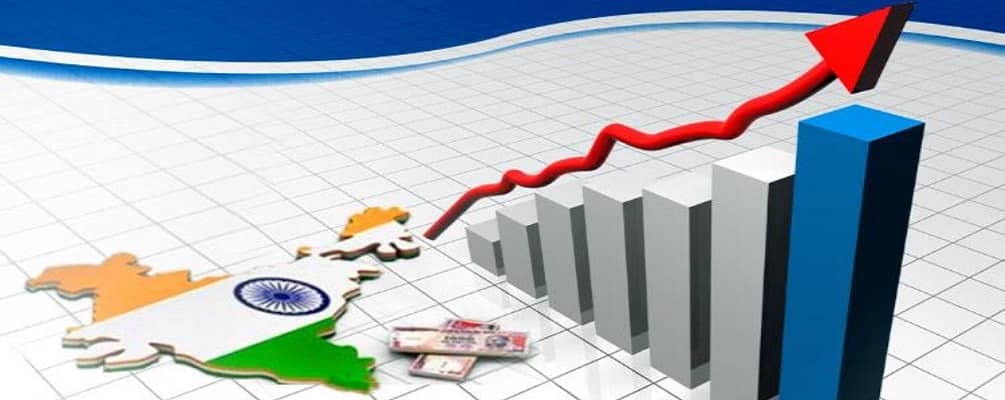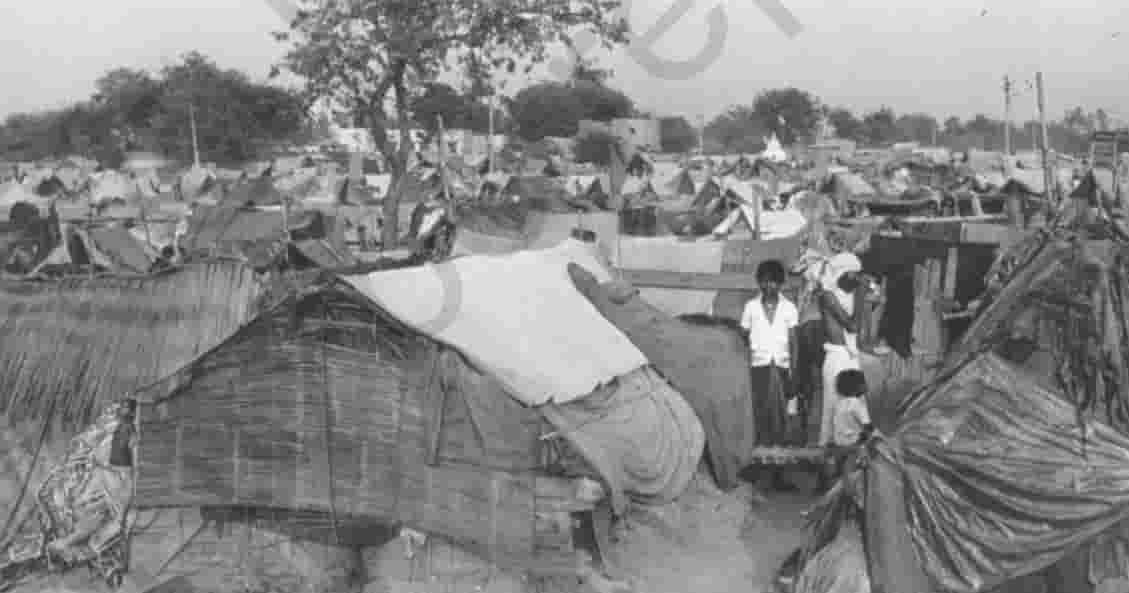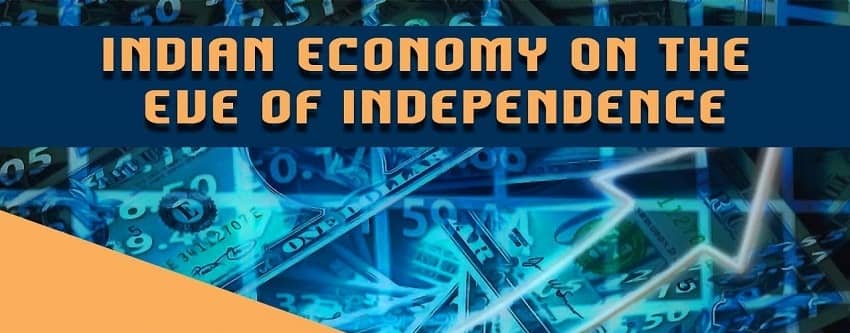Here we are going to cover the Indian Economy on the eve of independence (1947).
So, its name says Indian economy on the eve of independence (1947), we are going to cover that what was the state and condition of the India that was in the year 1947 or as we inherited from the Britishers.
Here we are studying the Indian economy on the eve of independence (1947). Definitely, we have to pay our attention to the industrial sector, some about foreign trade and agriculture sector.
Because after their analysis, we will come to know that how was the condition of our Indian economy o the eve of independence (1947).
Plus, we will study the demographic profile, occupational structure and the social and economic infrastructure.
During the British Raj that is before the eve of independence, there was the unlimited exploitation in all the three sectors, say for instance, in the agriculture sector, we will look at the zamindari system.
How our agriculture remained stagnant and backward in the Indian economy on the eve of independence (1947). Then we will learn about the industrial sector, how the Britishers exploited it.
The decay of handicrafts and how our modern industry stopped growing.
Thirdly International state, in this, we will study how British policies made our foreign trade restricted and that contribute to our Indian economy was very less.
So, these are the things which we are going to cover in this article. First, we will be covering features of the Indian economy on the eve of independence (1947) before moving on to the Agriculture sector.

Features of the Indian economy on the eve of independence:
- Stagnant economy: it is a type of economy where the growth is very slow or very less.
For a long period of time, there was no advancement and no growth in the Indian economy. So, the standard of living of people was very, very low.
The per capita income also was so less; it was around 0.5% per annum. Our maximum of the population or bulk of the population was suffering from massive poverty.
So, because our country was going through poverty, that’s why our economy was stagnant on the eve of independence (1947).
It shows us that people were also lacking job opportunities in the Indian economy on the eve of independence (1947).
- Backward economy: it was stagnant but backward also. Backwards why? When a country has low per capita income that eventually becomes a backward economy.
From 1947-48 it was Rs. 230. So, now you can imagine how much backwardness was there in the Indian economy (1947).
Because there was no sufficient food, clothing, shelter etc., besides most of the people or you can say a large chunk of the population was fully involved in the agriculture sector. Why it was so?
Because there were no employment opportunities for others, that is why our economy was backwards one on the eve of independence (1947).
- Agricultural backwardness: although people were mostly engaged in the agricultural sector.
72% people by that time (1947-48) and before that time or a few years after independence they were engaged only in this sector. The contribution that made to the GDP was only 50%.
It obviously proves our point that there was agricultural backwardness because there was low productivity in the Indian economy on the eve of independence (1947).
Here people used to perform subsistence farming; it means the farming that is done to meet the basic needs. So, again here there was no commercialization, nothing for market etc.
That is why this led our Indian economy to agricultural backwardness.
- Industrial backwardness & Heavy dependence on imports: actually, these two points are linked to each other. What industrial backwardness mean?
Because most of the population was busy in the agriculture sector, this shows us that other industries were lacking in job opportunities as at that time, heavy industries did not exist.
Also Read: Factors responsible for the development of tourism in India
Even small-scale industries like, handicraft industry, it was also decayed now. Due to these things, there was industrial backwardness, and specifically, we used to depend on all of those finished goods imported from Britain.
These finished goods were not produced in our country; we were dependent on others; that’s why industrial backwardness existed in the Indian economy on the eve of independence (1947).
Because of Britishers, our country became the net exporter of raw materials and importer of the finished goods.
For them, India was the market for the finished goods, and this is the reason why they were heavily dependent on them.
- Poverty & Limited urbanization: as I said prior, our country was lacking in employment. Nobody was earning anything, so this gave birth to poverty, and there was no food, no shelter, no clothes etc.
There was only limited urbanization in the Indian economy on the eve of independence (1947). After independence in 1948, only 14% of the population lived in urban areas.
 However, 86% of people lived in rural areas. That means their direct source of livelihood was agriculture, but it also shows that there was a lack of opportunities outside agriculture in the Indian economy (1947).
However, 86% of people lived in rural areas. That means their direct source of livelihood was agriculture, but it also shows that there was a lack of opportunities outside agriculture in the Indian economy (1947).
So that is why there were poverty and limited urbanization in the Indian economy.
- Poor infrastructure: what it shows is that there was no sign of advancement, no means of communication, no means of transportation, and then again generation of power all these things were not developed, nor they were introduced.
FOREIGN TRADE:
Since India has been an important trading centre since old times, but there were many restrictions or restrictive policies made by the British government, which adversely affected our structure, trade and composition of our trading market.
AGRICULTURE ON THE EVE OF INDEPENDENCE (1947):
In the agriculture sector, if we talk about before 1947 and after a few years of the eve of independence (1947), around 80% of the population was engaged in agricultural activities.
Why? Because around 80% of people lived in villages, so, most of their livelihood used to come from agriculture. People used to grow crops and then consume them.
From there only they got their livelihood. It shows us that if these many people were busy in the agricultural sector, then this sector could have grown better, flourished more but no, it was not like that.
Two words can describe the Indian agriculture sector in 1947, and that is Backwardness and Stagnant. So, our agriculture of the Indian economy on the eve of independence (1947)was Backward and Stagnant, why it was so? You will think.
To answer your questions, we are further going to cover some reasons why there was so much backwardness in the Indian economy:
- Low production and productivity: production means total output and productivity is output per hectare land.
In the agricultural sector, before 1947 and a few years after independence, our production or productivity was deficient.
If production or productivity is low despite the fact, those many people were engaged, so it implied that the sector was low.
This gap is showing that our agriculture sector was stagnant in the Indian economy on the eve of independence (1947).
- A high degree of uncertainty: uncertainty is when we are not sure about something.
Now what this point means is that, even now when we are having our permanent means of irrigation like dams, tube well etc. but still our farmers are dependent on rainfall.
They think if rainfall is good this year, then only their production will be good enough and if there is no rainfall, then there isn’t going to be a good crop.
So, if we compare today’s agriculture to prior 1947 when there were no permanent means of irrigation, Britishers did not ensure that the agriculture sector should move forward. That’s why farmers were majorly dependent on rainfall in the Indian economy at the eve of Independence (1947).
- The dominance of subsistence farming: at that time whatever farmers used to grow they were doing it for themselves, or we can say, for their own consumption and at that time they didn’t have the commercial outlook.
Because there was a dominance of subsistence farming, this was another reason why it was backward and stagnant.
- Small and fragmented landholdings: fragmented means when a piece of land is divided into many small bits and pieces. For instance, there is a new shopkeeper in the market, and he has done a lot of investment in his new shop, but the shop is tiny.
And we will take another example of a mall where there is a lot of outlets in one place. So, who will earn more? Obviously, the mall’s owner.
Why? Because at the mall a person can find everything and maybe at the shop of that shopkeeper, a person won’t find something. It makes it clear that the mall’s owner will earn more than the shopkeeper. Let’s now relate this example to this feature.
Now landholdings were fragmented, and they were small, their cost of production was high, but their output was low. Also, these landholdings were uneconomical in the Indian economy on the eve of Independence.
ZAMIMDARI SYSTEM:
Lord Cornwallis introduced this in 1793 who was the member of the British government, and the zamindari system was also known as Permanent settlement. In this system, zamindar was made the owner of a piece of land. He used to collect the land revenue from people living on his land. In that revenue, 89% was given to the British government and left 11% was provided to zamindar itself. A zamindar was appointed for 10 years by signing a contract, and they were also given the hereditary rights.

